Nine years ago I was a 21 year old with a camera, a couple lenses, and a newschoolers account. I had spent a season or two skiing with my friends, lining up shots with them, figuring out how to make decent photos. And then, thanks to this website, I started getting opportunities to shoot real events, with pro skiers, and other photographers and prize checks and the whole nine yards. The first couple events I shot came with a steep learning curve. Shooting a comp is a very different experience, and requires a different approach than just trying to make your friends look as good as possible.
These days, my photography has mostly reverted back to shooting with individual skiers, outside of a comp setting, but I’ve found myself shooting a couple of bike events recently, and relearning the patterns that took me so long to figure out. So, here’s the article I wish I’d had nine years ago when I was just getting started. These aren’t hard and fast rules, instead they’re general ideas that I’ve learned that can be applied anywhere from your local rail jam to the X Games.
Make a Plan
One of the biggest challenges I experienced, transitioning from shooting one-offs to shooting comps, was building a system to make sure I produced good coverage. With your friends, you don’t need to have a plan, you can just ski, let things flow, and figure out what might look good, and what your skier wants to hit.
But, in a comp setting, everyone has a plan. The organizers have a plan for when and where skiers will be riding. The outlet you’re shooting for has a plan for what they want their coverage to look like, and when they want it to come out. The skiers have a plan for what tricks they want to do where. So, if you show up without a plan, you’re going to have a hard time. Learn the other plans, learn the start list and the schedule, be clear with your outlet about what they’re looking for, and then make your own plan based on those factors.
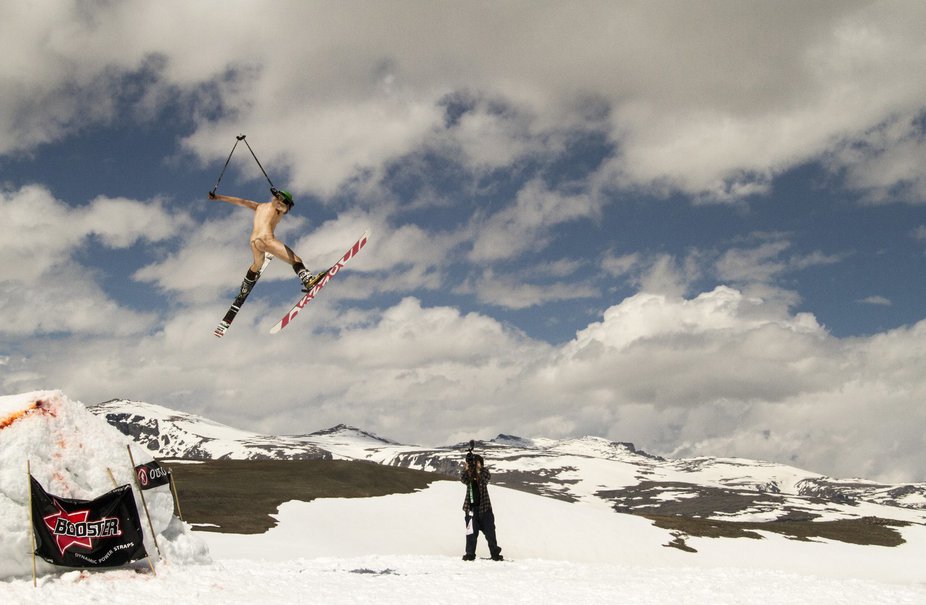
It's sorta impossible to plan for a surprise BN run, but sometimes you get lucky!
That plan can be flexible, it can change and evolve. But having some idea of “I’m going to shoot from this angle with a long lens, and then transition to here, and shoot wide, and then I’m going to set up here to get a couple shots of skiers reacting to their scores” goes a long way when you’re showing up at an unfamiliar venue to shoot. Make a plan that interfaces well with everyone else’s plans, and you’re set up for success at the get-go, instead of stumbling into it.
Learn the Rules
Every venue and competition will have different rules. They’ll have zones you are and aren’t allowed to shoot from. They’ll have a schedule for where and when you can pick up your credentials and comp ticket, when photographers should get up to the hill, when the first athlete will drop, and when podiums will occur. Learn the rules.
If you’re not sure where you’re allowed to shoot from, ask someone official looking. If they don’t know, choose a spot that you’re sure is out of the way of the athletes and set up there until you get in trouble. Nothing hurts your chances of doing good work like getting banned for poaching an off-limits area. Learn the rules, build your plan around them.
Nail your Backup
This one’s pretty personal, but I really like to shoot a backup or contingency plan really quickly, as soon as I show up. This is the bare minimum that it would take to create the content I’m planning on publishing. For web articles, that’s usually three to five good action shots (all with different angles/focal lengths) , two B-roll images to set the scene, and an action or lifestyle shot of the top podium favorite. I’ll back those images up to the cloud from my phone, as soon as I’ve shot them. That way, even if something catastrophic happens and I’m unable to shoot the rest of the comp, I’ve still got the tools to do my job.
Get a Variety of Shots
One of the reasons shooting a competition is so challenging is that in the moment, it often feels like you need to get the same shot of every athlete so that you’re guaranteed to have the podium finishers covered. And, while that’s admirable, it usually doesn’t really fit your end goals. Sure, that might work if you’ve been hired by the venue to sell photos to competitors, but if you’re there to produce coverage for any kind of print or online outlet, it’s a terrible idea.
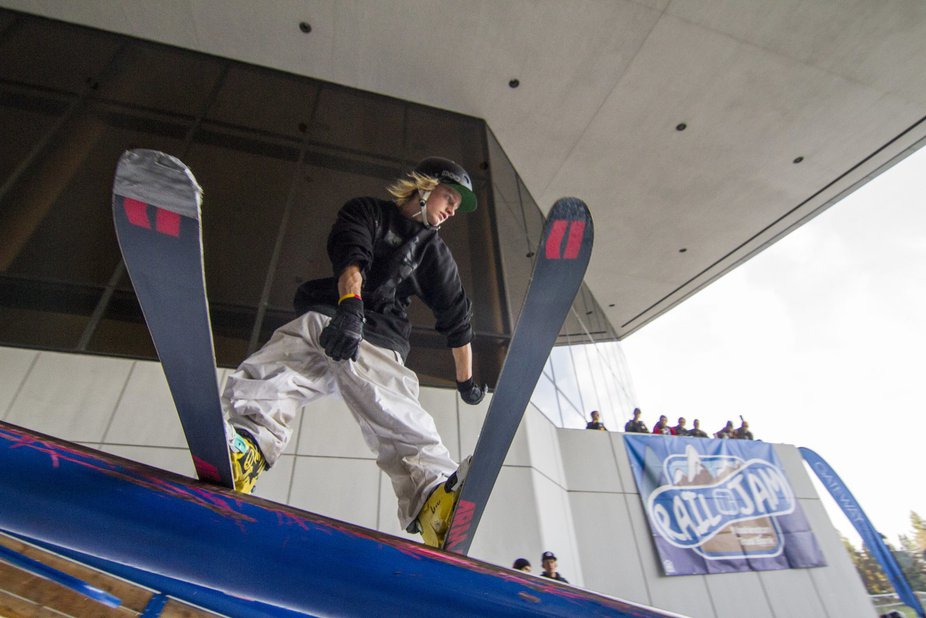
Getting a few wide angle shots helps break up the monotony of 70-200mm shots that make up the majority of coverage.
Instead, work to get a variety of shots, with different perspectives. Shoot both landscape and portrait. Usually at a comp there will be one or two shots that make a ton of sense. These are the photos everyone will be lined up to get. So grab a couple of shots from those areas, with the nice lake in the background, or the clean sky, or whatever it is. But don’t just shoot every run the same way. Switch up focal lengths and vantage points. Vary the amount of space the skier is taking up in your frame. Grab some reaction shots of the crowd. Create visual interest through variety. Nobody wants to scroll through 36 photos with the same lens and vantage point of different skiers doing different spinny flippy things. Change things up, keep it fresh.
Be Prepared
This one is obvious, but in the excitement of shooting a big event, it can be easy to overlook the obvious and show up with no SD card or a dead battery. Make sure your batteries are charged. Make sure you have extra cards. Make sure you never formatt a card that hasn’t been backed up. Bring a power bank and cables so you can charge on the fly. Having your shit together makes it a lot easier to do your job.
And if it’s your first big break, your first major comp, be over-prepared. Borrow an extra body just in case. Triple check your gear. Things go wrong. Cameras malfunction. Batteries die in the cold. SD cards get corrupted. Bring backups. Adapt. Overcome.
Tell a Story
This applies anytime you’re shooting, but good photography usually comes with an element of storytelling. The story can be as simple as “she took off over there, she’s gonna land over there, and I took a photo in the middle.” But for there to be a story there needs to be context. That’s why guy-in-the-sky photos suck. No context = no story.
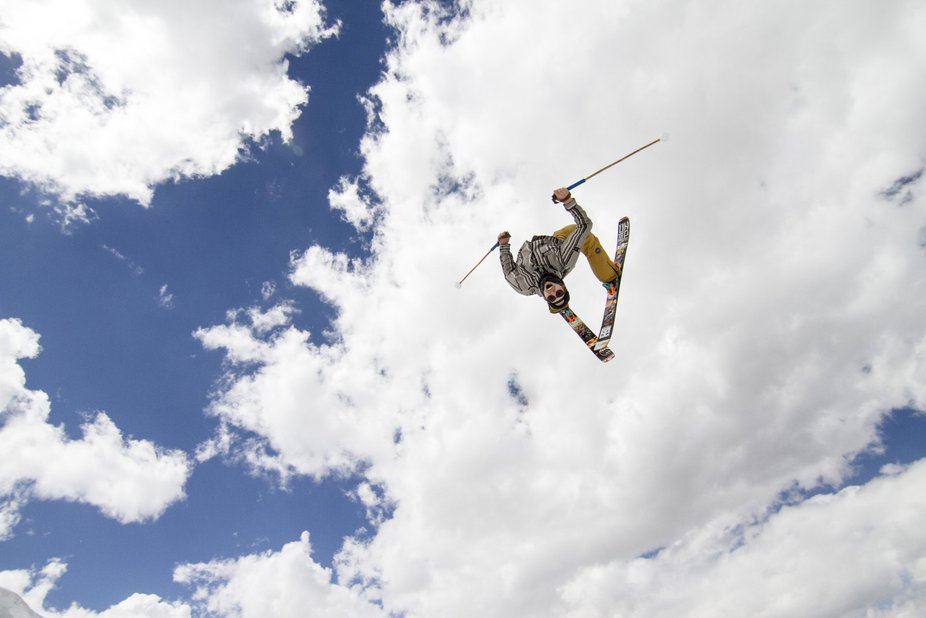
Rules are made to be broken. Sometimes the guy is really high in the sky, and the sky is really cool.
This ties into the “get multiple angles” point. Shooting a variety of angles and features adds to the storyline and drama. Even if everyone is doing their biggest trick on the same feature, get some good shots of people dropping in, or skidding to a stop after. Vary what you shoot. Get shots of the judges or course marshals. Get shots of park crew if they touch up a feature. Your audience doesn’t just want one shot of the winner doing their biggest trip, they want an impression of the arc of the whole event. Shoot that arc.
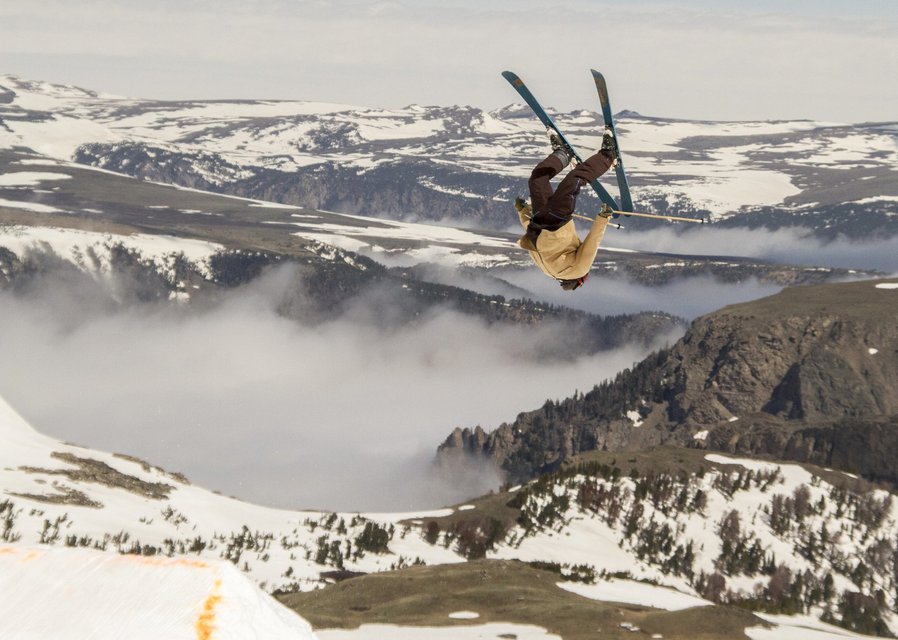
Same jump, same trick, different angle, different skier, different addition to the story.
Be Versatile
No matter what you think of social media, it’s the way of the world these days. And if you can grab a quick phone clip or two for social media, your bosses will thank you. It’s not hard to shoot a run with your phone in one hand and your camera in the other. Get a clip or two, and get them over to your outlet while you’re shooting so that they can have a little live coverage.
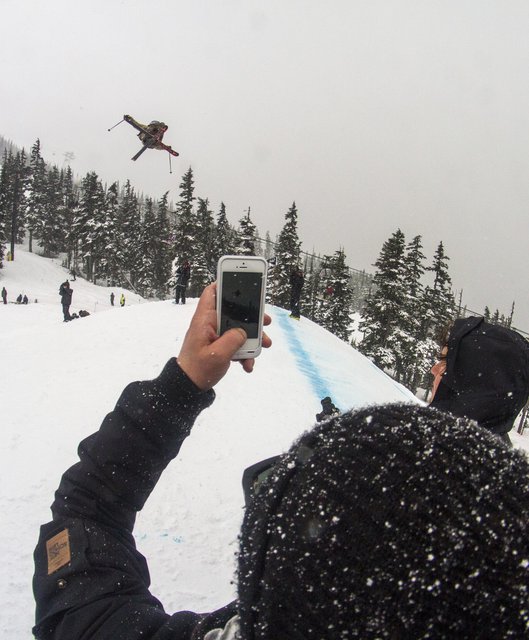
Mr. Bishop getting the shot for Snapchat, back before Instagram stories were a thing.
Be Prompt
Again, social media means that there will be phone clips of the best tricks and runs up as soon as they happen. As a photographer, you’re not necessarily trying to compete with that, but working quickly helps both yourself and your outlet. Taylor your workflow so that you can get your shots edited and submitted as quickly as possible. That can mean editing on an ipad or laptop in the lodge, as the event winds down. Regardless, do your job quickly and well. Get it done before you party. Then you can go out on the town with a clean conscience. Editing photos is easiest right after you shoot them. You remember their context better, so it’s easier to write captions, and your artistic intent is still fresh in your mind so you can edit to match what you imagined.
Shoot your photos. Edit them. Submit them, then go party, or hit the spa, or ski for yourself or whatever. It’s always better and easier to do your job, and then relax.
Take Care of Yourself
Finally, the hardest one for last. Take care of yourself. Please. Your work will only be as good as the state of mind you’re in while shooting. So make sure you’re in a good place mentally and physically.
Bring more insulating layers than you think you need. Bring extra mittens. Bring sunscreen and lip balm (and use them before you need them.) Drink lots of water, even if you don’t want to. Bring electrolyte tablets to add to your water. Make sure your boots are comfy. Bring lots of snacks. Bring a leatherman or equivalent multitool. Bring extra contacts or glasses.
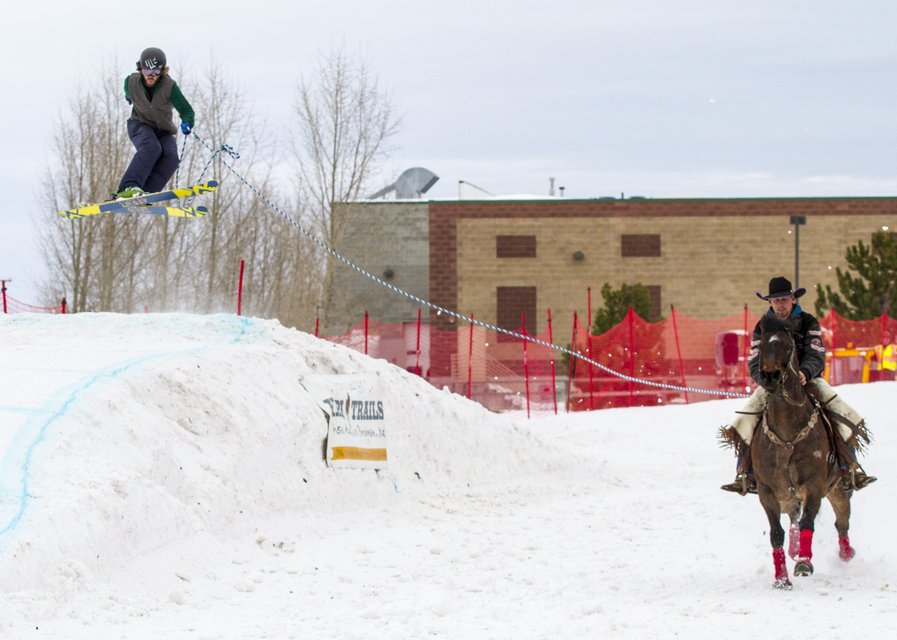
I almost got frostbite this day. I did not get good shots. Lesson learned.
Get an old foam sleeping pad and cut a seat sized chunk off so you’ve got something comfortable and insulated from the snow to sit on. Shooting skiing involves a lot of sitting and standing around in the snow.
Don’t count on the media tent, or its equivalent, to be a perfect oasis in the storm. Sure, sometimes they have all the food and drink and charging ports and wifi you could ever ask for. But often there’s not much in the way of amenities for the media. So be prepared to be self-sufficient. Create a space that enables you to do your job well.
Conclusion
Shooting ski competitions is awesome! But there can be a steep learning curve. Make a plan, be prepared, and most of all, make the most of it. Any opportunity worth pursuing is worth savoring.

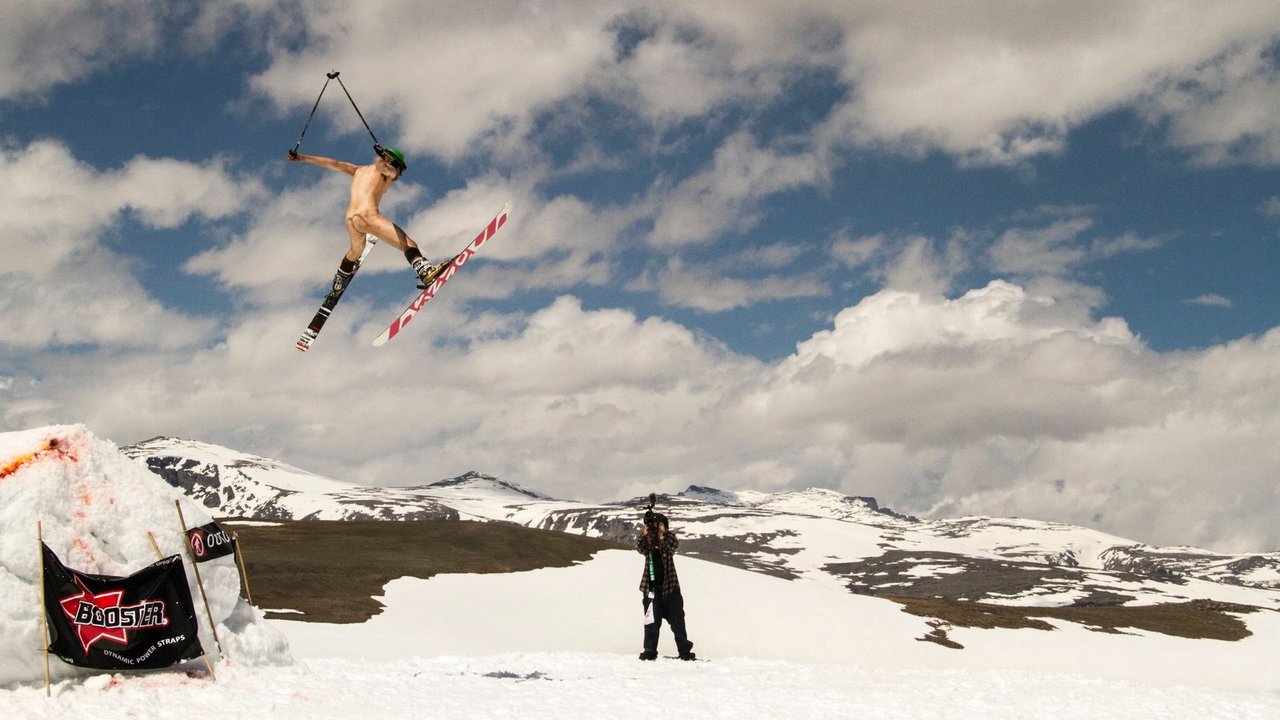
Comments